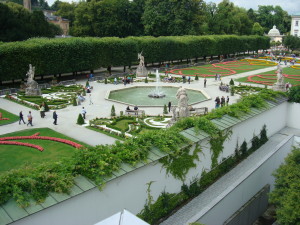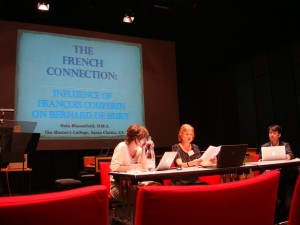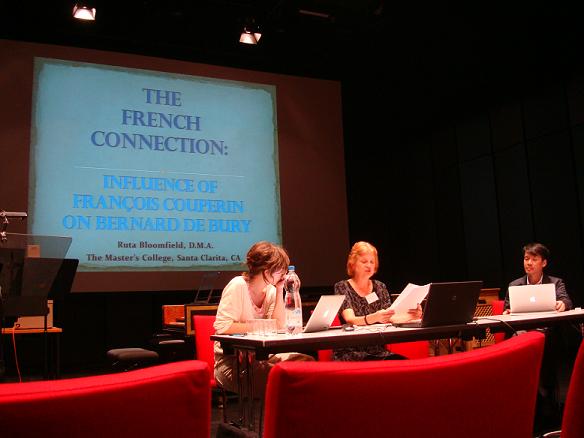The 16th Biennial International Conference on Baroque Music (ICBM) took place in Salzburg, Austria, July 9-13, 2014. Since its inception in the 1980’s, this conference has established itself as one of the largest and most important musicological meetings on the academic calendar. This year’s meeting attracted close to 250 scholars from all over the world, including Western and Eastern Europe, UK, US, Canada, Australia, Chile, Israel, Taiwan, and Hong Kong.
The venue was The University Mozarteum with Dr. Thomas Hochradner serving as Conference Coordinator. Arriving in Salzburg was a homecoming of sorts for me, having spent an undergraduate academic year abroad there, attending both the University of Salzburg and the Mozarteum.

Six parallel strands encompassing sixty-five different thematic lines meant that it was often difficult to decide which presentations to attend. Sessions I attended include the following (some titles below are shortened).
- “Jacques Duphly’s Use and Incorporation of the Italian Style in His Second Livre de pièces de clavecin” (Lysiane Boulva)
- “French Harpsichord Doubles and Creativity in the 17th-Century Keyboard Tradition” (David Chung)
- “The French Connection: Influence of François Couperin on Bernard de Bury” (Ruta Bloomfield)

- “How to Enhance the Continuo Accompaniment of an Air by Our Choice of Harmony and Ornament” (Thérèse de Goede)
- “Expressive Engagement and Emotional Distance in Productions of Bach’s Matthäus-Passion” (Uri Golomb)
- “A Misunderstood Notation in Baroque France” (Shirley Thompson)
- “Hidden Forms of Inversion Inside the Contrapunctus ‘in stylo francese’ of The Art of Fugue of J. S. Bach” (Konstantinos Alevizos)
- “A Dorian Middleground Schema in Bach’s Minor-Key Fugue Expositions” (Michael Baker)
- “Arcangelo Corelli in 18th-Century American Musical Culture” (Gregory Barnett)
- “What’s Really Crooked and Straight in ‘Ev’ry Valley’?” (Fred Fehleisen)
- “Moses Mendelssohn on the Sublime in Music and Poetry” (Yaël Sela-Teichler)
- “French Music and Musicians during the English Restoration” (John S. Powell)
- “A Re-Examination of the Instrumental Music by José de Nebra” (Luis Antonio González Marín)
- “Musical Sources of Domenico Scarlatti in the Music Archive of the Cathedrals of Zaragoza” (Celestino Yáñez Navarro)
- “Heinrich Biber, Instrumental Music, and the Liturgy” (Kimberly Beck)
- “Vincenzo Galilei and the Well-Tempered Lute” (Žak Ozmo)
- “Morality, German Cultural Identity, and Telemann’s Faithful Music Master” (Steven Zohn)
- “Images of Bach as Reflected in 20th-Century Compositions” (Yulia Kreinin)
- “Credit, Debt, and Economic Survival in the Electoral Saxon Hofkapelle of Heinrich Schütz” (Gregory Johnston)
- “Dazzling Divas of Dresden: Selected Solo Repertoire of Singers Associated with the Dresden Augustan Court in the Mid-18th Century” (Patricia Corbin)
- “A Romantic Approach towards J. S. Bach’s Chaconne by Felix Mendelssohn and Robert Schumann” (Hildrun Haberl)
- “Distinguishing between Passacaglia and Ciaccona in the Organ Works of Dietrich Buxtehude” (Vincent P. Benitez)
- “Ringing Down the Curtain” (Rebecca Harris-Warrick)
- “Exemplars from Johann Mattheson’s Grosse General-Bass-Schule” (Lawrence Molinaro)
- “The Story of Dame Nellie Melba’s 1907 Recording” (Graydon Beeks)
Participants enjoyed three outstanding concerts. Lecturers of the Institute for Early Music at University Mozarteum joined forces for a concert called “Viaggio musicale”. Mülln Parish church was the site for music with the theme of “Mozart and the Salzburg Baroque Heritage”. The final “Delegates’ Concert” featured performances by various presenters.
A selection of music-related tours enhanced the conference. Choices included: “Traces of Music in Salzburg”; “Stiftung Mozarteum: The Autographs’ Vault”; “The Organs in Salzburg Metropolitan Church”; and “DomQuartier”, the newly opened complex of the archbishop’s palace.
The conference experience was crowned by the conference dinner held in the Festung Hohensalzburg, the spectacular medieval fortress looming over the city. Delegates were treated to a gourmet meal, early music entertainment, great company, and spectacular views.
Meeting participants from all over the world was certainly an additional highlight of the trip. At least four of us travelled on to Vienna directly afterwards, meeting each other on the train, in the Kunsthistorisches Museum, and at St. Stephen’s Cathedral.
The next ICBM conference will be hosted by Christ Church University, Canterbury, UK in 2016.
By WEKA Member, Ruta Bloomfield, D.M.A., The Master’s College, Santa Clarita, CA
